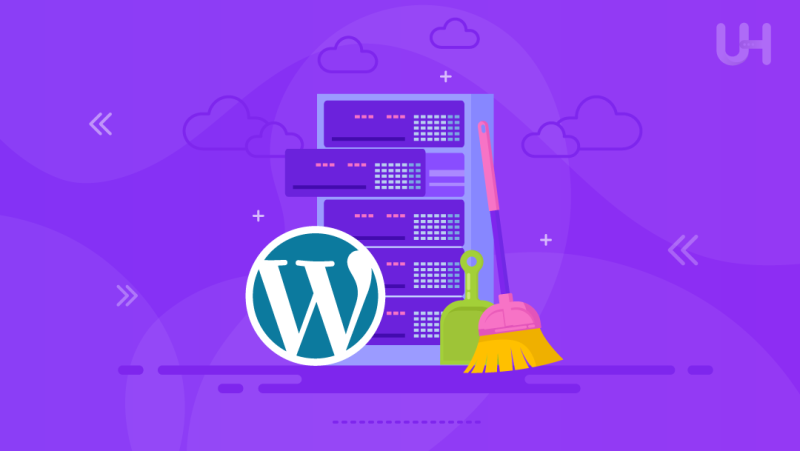Effective management of disk space is important for the optimal functioning of a WordPress website. Just as maintaining a tidy workspace enhances productivity, organizing and optimizing storage space ensures that your website operates smoothly and delivers an exceptional user experience.
In this blog, we’re going to discuss how to clean up and organize the storage space on your WordPress website. We’ll look at simple and effective ways to free up space so your website can perform at its best. By following these tips, you’ll not only make your website faster but also make it easier to manage.
Best Ways to Optimize WordPress Disk Space
Maximizing the efficiency of your WordPress website’s storage capacity is crucial for ensuring optimal performance and streamlined operations. Let’s check out some ways to optimize WordPress disk space:
Assessing Disk Space Usage
Disk space usage in WordPress hosting refers to the amount of storage occupied by various components of your website, including media files, plugins, themes, and databases. Each element contributes to the overall consumption of disk space, impacting the performance and efficiency of your website. By comprehending how these components utilize disk space, website administrators can effectively manage and optimize storage resources.
Tools and Methods to Measure Disk Space Usage Accurately
Utilizing tools and methods to accurately measure disk space usage is essential for identifying areas of inefficiency and potential optimization. WordPress hosting platforms often provide built-in tools for monitoring disk space usage, offering insights into which components are consuming the most storage. Additionally, third-party plugins and server management tools can provide more detailed analytics and recommendations for optimizing disk space usage.
Identifying Areas of High Disk Space Consumption
Identifying areas of high disk space consumption involves analyzing the storage usage of different components within your WordPress website. Media files such as images, videos, and audio files can often be significant contributors to disk space consumption, especially if they are not optimized or regularly pruned. Similarly, plugins and themes may accumulate over time, consuming additional disk space even if they are not actively used. By pinpointing these areas of high consumption, website administrators can prioritize optimization efforts to free up valuable disk space and improve overall website performance.
Optimizing Media Files
Image optimization is a key technique for reducing the size of media files without sacrificing visual quality. By using image compression tools or plugins, website administrators can significantly decrease the file size of images uploaded to their WordPress site. This not only conserves disk space but also improves website loading times, enhancing the user experience. It’s important to strike a balance between file size reduction and image quality to ensure that visuals remain crisp and engaging.
Deleting Unused Media Files and Attachments
Over time, WordPress websites can accumulate unused media files and attachments that contribute to unnecessary disk space consumption. Regularly auditing and deleting unused media files can help free up valuable storage space. Website administrators can utilize the media library in WordPress to identify and remove redundant files, ensuring that only essential media assets are retained. Additionally, plugins or scripts can automate the process of cleaning up unused media files, streamlining maintenance efforts.
Using External Storage Solutions for Media Files
Leveraging external storage solutions, such as cloud storage services or content delivery networks (CDNs), can alleviate the burden on your WordPress VPS hosting server and reduce disk space usage. By offloading media files to external storage platforms, website administrators can effectively scale their storage capacity without increasing hosting costs. CDNs, in particular, can distribute media files across multiple servers worldwide, improving website performance and reliability. Integrating external storage solutions with WordPress is straightforward, with many plugins and services offering seamless integration options.
Ready to Optimize Your WordPress Hosting?
Start optimizing your WordPress hosting today with Ultahost’s reliable and lightning-fast hosting services. Explore our WordPress hosting plans now!
Cleaning Up Plugins and Themes
Inactive plugins and themes not only occupy disk space but also pose security risks and can potentially slow down your WordPress website. It’s essential to regularly audit your installed plugins and themes and remove any that are no longer in use. The WordPress dashboard provides a convenient interface for deactivating and deleting plugins and themes that are not actively contributing to your website’s functionality. By eliminating unnecessary plugins and themes, you can free up valuable disk space and ensure a leaner, more secure website environment.
Identifying and Replacing Resource-Heavy Plugins
Some plugins may be resource-intensive and consume disproportionate amounts of disk space, CPU, or memory resources. Identifying and replacing these resource-heavy plugins is crucial for optimizing your WordPress website’s performance and efficiency. Monitoring tools and performance analytics can help identify plugins that are causing performance bottlenecks or excessive disk space usage. Once identified, seek alternative plugins with similar functionality but lighter resource requirements. Conducting thorough research and testing ensures that replacements meet your website’s needs while minimizing resource consumption.
Streamlining Theme Usage to Reduce disk space usage
WordPress themes often come with a variety of features and functionalities, some of which may not be necessary for your website. By streamlining theme usage and opting for lightweight, minimalist themes, you can reduce disk space usage and improve website performance. Evaluate your current theme’s features and assess whether all components are essential. Consider switching to a more streamlined theme or customizing your existing theme to remove unnecessary elements. Additionally, regularly updating themes ensures that you benefit from performance optimizations and security enhancements, further enhancing disk space efficiency.
Managing Database Bloat
Over time, the WordPress database can accumulate unnecessary data, leading to database bloat and increased disk space usage. It’s essential to regularly clean up the database to remove redundant data and optimize its performance. WordPress provides built-in tools and plugins that enable administrators to perform database maintenance tasks efficiently. These tasks typically include deleting spam comments, post revisions, transient data, and other unused or outdated records. Regular database cleanups help improve website performance, reduce server load, and free up valuable disk space.
Optimizing database tables to reduce overhead
Database tables can become fragmented and inefficient over time, leading to increased overhead and reduced performance. Optimizing database tables involves organizing and optimizing data storage to minimize overhead and improve query performance. WordPress plugins and database management tools offer features for optimizing database tables automatically. These tools analyze database structure and usage patterns to identify and address inefficiencies, such as fragmented indexes or unused space.
Utilizing plugins for automated database maintenance
WordPress offers a plethora of plugins specifically designed for automated database maintenance tasks. These plugins streamline the process of database cleanup, optimization, and maintenance, allowing administrators to schedule routine tasks and automate tedious processes. Popular database maintenance plugins offer features such as scheduled cleanups, optimization routines, database backups, and performance monitoring. Administrators can configure these plugins to run at specified intervals, ensuring that database maintenance tasks are performed regularly without manual intervention.
Implementing Content Delivery Networks (CDNs)

Content Delivery Networks (CDNs) work by distributing website content across a network of servers strategically located in various geographic regions. When a user accesses a website, the CDN delivers content from the server nearest to their location, reducing latency and improving page load times. By offloading static content, such as images, CSS files, and scripts, to CDN servers, the workload on the origin server is significantly reduced, resulting in lower server load and decreased disk space usage.
Integrating CDNs with WordPress for efficient content delivery
Integrating a CDN with WordPress is a straightforward process that involves configuring the CDN settings within your WordPress dashboard or using a CDN plugin. Many CDN providers offer dedicated plugins or integration guides tailored specifically for WordPress users. Once integrated, the CDN automatically caches and delivers static content, such as images, CSS files, and scripts, from CDN servers, thereby improving website performance and reducing server load. Additionally, some CDN providers offer advanced features, such as image optimization and lazy loading. Moreover, optimizing content delivery and reducing bandwidth consumption.
Evaluating CDN options and selecting the right one for your website
When choosing a CDN for your WordPress website, it’s essential to consider factors such as performance, reliability, ease of integration, and cost. Evaluate different CDN providers based on their network coverage, server locations, caching capabilities, and pricing plans. Consider your website’s specific requirements, such as traffic volume, geographic distribution of visitors, and content delivery needs. Additionally, look for CDN providers that offer robust security features, such as DDoS protection and SSL/TLS encryption, to safeguard your website against cyber threats.
Utilizing Caching Mechanisms
Caching is a crucial technique for optimizing website performance and reducing disk space usage. When a user visits a website, their browser retrieves various elements. It includes images, CSS files, and JavaScript, from the server hosting the website. Caching allows these elements to be temporarily stored (or cached) on the user’s device or in intermediary servers, such as CDN edge servers. This means that subsequent visits to the same website can load these elements more quickly, as they are retrieved from the cache rather than from the origin server.
Implementing caching plugins to serve cached content efficiently
WordPress offers a wide range of caching plugins that automate the caching process and serve cached content efficiently to website visitors. These plugins generate static HTML versions of dynamic web pages and store them in the cache. When a user requests a cached page, the plugin retrieves the HTML version from the cache instead of generating it from the server. Ultimately, resulting in faster page load times and reduced server load.
Configuring caching settings for optimal performance and disk space savings
Configuring caching settings involves fine-tuning caching parameters to achieve optimal performance and disk space savings. Caching plugins typically offer configuration options, including cache expiration times, cache storage locations, and exclusion rules for dynamic content. Website administrators can customize these settings based on their website’s specific requirements and traffic patterns. For example, setting longer cache expiration times for static content that rarely changes can reduce the frequency of cache regeneration and conserve disk space. Additionally, configuring cache storage locations to utilize server-side caching or CDN caching can further optimize performance and reduce server load.
Conclusion
Efficient disk space management is essential for maintaining a high-performing WordPress website. We have discussed strategies and best practices for optimizing disk space usage. They are ranging from cleaning up media files to implementing advanced caching mechanisms and leveraging content delivery networks (CDNs). By following these techniques, website administrators can streamline their storage resources, improve website performance, and enhance the overall user experience.
Ready to optimize your WordPress hosting? Explore Ultahost’s range of affordable WordPress hosting solutions tailored specifically for WordPress websites. Enhance your website’s performance and reliability with our reliable services.
FAQ
Why is disk space management important for WordPress hosting?
Efficient disk space management ensures smooth website operation, quick loading times, and a seamless user experience. By optimizing disk space, you enhance performance, reduce server load, and boost overall reliability.
How can I assess disk space usage on my WordPress website?
Assess disk space usage using tools provided by your hosting provider or WordPress plugins. These tools offer insights into storage consumption by media files, plugins, themes, and database tables.
What are the best ways to optimize media files on my WordPress website?
Optimize media files by compressing images, deleting unused files, and utilizing external storage solutions like CDNs for offloading media content.
What is the role of caching mechanisms in optimizing disk space usage?
Caching mechanisms store static content temporarily and serve it efficiently to website visitors, reducing server load and conserving disk space.
How do I choose the right CDN for my WordPress website?
Consider factors like performance, reliability, ease of integration, and cost when selecting a CDN provider.











